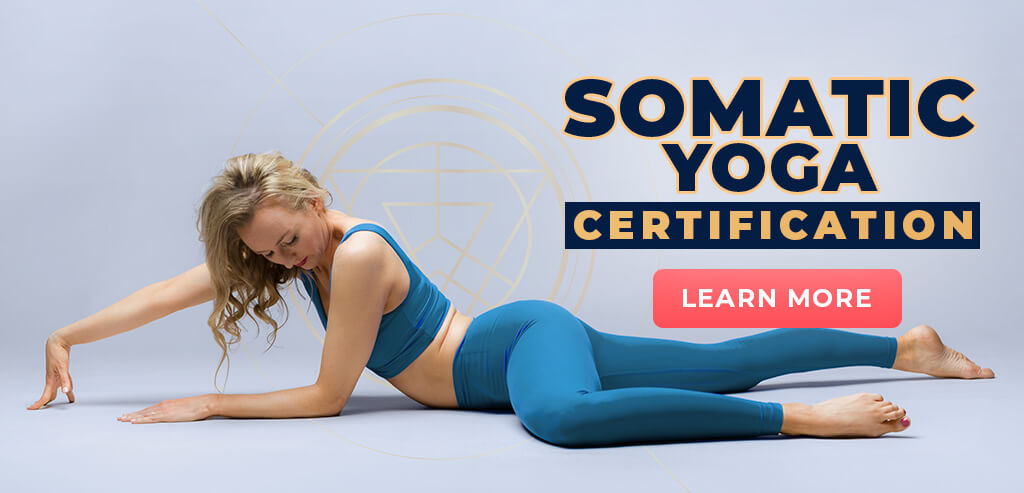If you’re like me, you were raised to believe that the body and mind were seperate.
In fact, this belief is deeply rooted in our culture. But it wasn’t always this way.
In fact, indigenous cultures were the first to follow somatic therapy and somatic practices through movement practices, somatic awareness, and understanding how psychological processes are a part of the mind body connection.
It’s only in the 20th century that the mind body connection has started getting the attention it deserves in modern culture. This holistic approach can help treat trauma, offer us better coping techniques, and deeper self awareness.
As a human being, your bodily wisdom is intricately linked with your body’s ability to practice mindful movement. Your mind, body, and spirit are all in constant connection.
So, today I want to help you understand the history of somatic yoga.
But first, we need to define what somatic yoga even is…
What Is Somatic Yoga?
Somatic yoga is a deeply restorative practice that bridges mindful movement with body awareness s to calm your central nervous system, assist with healing trauma, and ultimately, foster healing and connection through intuitive movement patterns.
Rooted in both cognitive science and the body’s wisdom, somatic practices encourage you to listen to your internal awareness and physical sensations, release built-up chronic tension, and restore the natural energy flow of your entire system.
Somatic experiencing and somatic thinking are less about perfecting poses and more about following somatic techniques which honor your internal experience and felt sense, helping you move in your own method with intention, ease, and self regulation.
By focusing on how movement feels rather than how it looks or specific muscular patterns, somatic yoga invites you to become an active participant in your own treatment by allowing you to create a deeper connection with all parts of yourself through somatic exercises and somatic movement. Think of it as body psychotherapy.
What’s the Difference Between Somatic Yoga and Traditional Yoga?
The short answer is somatic movement. Somatic movement is an intuitive practice that encourages you to explore and move your body in your own way, trusting your intuition and your own sense of what your body wants. In a sense, you’re allowing your body’s wisdom to take over and in the process, deepening your body awareness.
While traditional yoga practices, like Hatha, Vinyasa, and Ashtanga, follow asanas and emphasize physical alignment, disciplined movement, and focused attention, to achieve enlightenment (samadhi), somatic yoga takes a profoundly different approach.
Rather than taming the mind and forcing the body into rigid poses, somatic yoga seeks to help you get into your intuitive zone, quieting the mind so you can activate the body’s innate healing wisdom, helping you release trauma and unhelpful patterns stored in your tissues. You don’t need a clinical somatic education to do this. All bodies know how to heal. Through deepening your body awareness, somatic practices help you move intuitively, knowing when to tense and when to have relaxed muscles.
For example, you might get into the typical 20th century version of Cat/Cow, but decide to start incorporating other movements, like shaking, undulating, or moving into a different form. In somatic therapy, bodies can move as they want to, not just as they are told. You enter into therapeutic techniques and a therapeutic relationship with yourself, all through intuitive movement practices.
A somatic educator can help guide you, but you don’t need movement education or a clinical somatic education to try somatic yoga poses. It’s not about improving posture or nailing the right techniques. The field of somatic movement patterns is all about following an inner process and allowing the development of your own inner guide.
Traditional yoga often uses structured asanas and alignment cues in repetitive flows, while somatic yoga embraces the organic, non-linear movements of nature—such as circles, waves, and even shaking—to create new neural pathways and deepen sensory awareness. Somatic educators can help you practice. And you can gain a somatic education on your yoga mat.
Instead of viewing bodies as something to overcome, somatic yoga sees the living body as a vital partner in the healing process, prioritizing embodied sensation and connection over external precision. Movement and intuition can help relieve muscular tension, chronic pain, and sensory motor amnesia.
Mostly, somatic practices put you in the driver’s seat of your healing. When your somatic education is combined with yoga, it’s supercharged.
But where did somatic yoga begin? What is the history of somatic yoga and somatic education?
Experience My Somatic Yoga Workshop (usually $67) FREE!👇

Where Does Somatic Yoga Come From?
The term somatic originates from the Greek word soma, meaning “living body.” It wasn’t until the twentieth century that various disciplines started to explore the field of somatic development.
The history of somatics is a rich tapestry woven from diverse traditions, blending ancient practices with modern scientific insights. Somatics emerged as a way to reconnect mind and body, emphasizing internal awareness and self-healing.
While the concept of embodied movement can be traced back to ancient philosophies, the field of somatics, as we know it today in the twentieth century was created by pioneers like Wilhelm Reich, Elsa Gindler, Heinrich Jacoby, Moshe Feldenkrais, Charlotte Selver, Thomas Hanna, and Stephen Porges.
These innovators, some even considered an American philosopher, explored the interplay between physical movement, neurology, and emotional health and well being, creating a foundation for somatic practices that continue to evolve and transform lives.
History Of Modern Somatic Yoga
1890s: A New Body Technique
Believe it or not, somatics started with an actor. The Alexander Technique was developed by F. Matthias Alexander, an Australian actor. He began formulating the method in the 1890s to address chronic vocal and breathing issues he experienced while performing.
By observing and refining his posture and movement habits, he created a system that teaches people to recognize and unlearn harmful physical patterns, promoting better alignment, coordination, and ease of movement. The technique gained recognition by the early 1900s.
1930s: Pain comes from defending
I won’t give you all the details but I want to give you a brief history so you understand how the term somatic has become so popular—and where it came from.
The origins of clinical somatic education can be traced back to Wilhelm Reich (1897–1957), an Austrian psychoanalyst who revolutionized the connection between the body and emotional health.
Reich developed Vegetotherapy, a groundbreaking therapeutic approach that involved physically simulating the bodily effects of strong emotions to release pent-up tension and pain.
Central to his work was the concept of “body armor,” areas of chronic muscular rigidity that he believed stored repressed emotions and defended against the flow of energy in the body.
Think about when a car accident happens. Your body immediately tenses up, creating a shield of protection from any incoming harm (like a crash!)
Through techniques and practices such as palpating tense areas, encouraging primal screaming, and exploring cathartic movements, Reich aimed to dissolve these blockages and restore well being.
His Segmental Armoring Theory identified seven key zones of the body where tension accumulates, sometimes causing pain, affecting sensory activities or hurting one’s well being, linking each to specific emotions and feelings.
As Reich famously observed, “Every muscular rigidity contains the history and the meaning of its origin.”
By breaking down these defenses, he believed, people could open themselves to the free flow of energy both within their bodies and in the universe around them. Ultimately, he discovered that pain comes from defending.
1930s: A New Way of Thinking about Movement
The 1930s saw big strides in connecting body and mind, thanks to pioneers like Elsa Gindler, Heinrich Jacoby, and Moshé Feldenkrais.
Gindler laid the groundwork for body-based therapy, focusing on mindful movement to release tension and boost awareness, becoming the first somatic educator.
Jacoby showed how simple, intentional actions could spark deeper self-awareness, while Moshe Feldenkrais explored how tuning into the body could help people heal themselves.
Their ideas shaped a new way of thinking about movement as a path to health and well being.
Take my feminine energy quiz to get a recommended practice for balancing YOUR feminine energy 👇
1960s: Awareness
Most people credit Thomas Hanna with coining the term somatics, but before his influence in the 1970s, Charlotte Selver was already paving the way in the 1960s.
Her work focused on studying and aligning with the process of nature, using body awareness practices and techniques as a tool for self-discovery.
Selver encouraged people to trust their inner experience, body awareness, and non-verbal sensations, believing these were keys to understanding themselves and their connection to the world, especially when trying to heal pain.
Her approach, known as Sensory Awareness, emphasized deepening our perception through the senses as a gateway to greater presence, authenticity, and harmony with life.
1970s: Somatics are Born
Thomas Hanna built upon the work of earlier pioneers, coining the term somatics to describe practices that integrate the body and mind. Hanna believed that all life experiences shape physical patterns in the body, sometimes resulting in what he called Sensory Motor Amnesia—a loss of awareness and control over certain muscle groups due to stress, crisis, or habitual use.
His approach emphasized slow, gentle techniques coordinated with breath to restore sensory-motor awareness and retrain the nervous system for ease and balance.
1990s: Polyvagal Theory
Stephen Porges introduced his Polyvagal Theory in the nineties, exploring the vagus nerve’s role in regulating emotions, social connection, and fear responses.
His work highlighted the nervous system’s “second defense system,” which triggers a freeze response instead of the fight-or-flight activation.
Porges proposed that this freeze state is controlled by the primitive dorsal branch of the vagus nerve, which activates only when the more advanced systems fail. His ideas offered new insights into the body’s stress responses and their connection to healing.
1995: Somatic Experiencing
Peter Levine published Waking the Tiger introducing Somatic Experiencing, a groundbreaking approach to therapy. Inspired by his observations of animals in the wild, Levine noted how they recover from bad experiences through natural processes like neurogenic tremors—physical shaking that releases pent-up survival energy.
His method uses a technique called pendulation, which gently guides people between states of tension and relaxation to help the body complete and release trapped survival responses.
By addressing the root cause of symptoms stored in the body, Levine’s work has profoundly influenced the field of somatic healing.
Is there any science behind somatic yoga?

Somatic yoga has gained recognition not only as a transformative practice, but also for its growing connection to scientific research in fields like neurology, psychology, and physiology.
While the term “somatic” has roots in ancient body-mind traditions, modern somatic practices, including somatic yoga for trauma, are increasingly supported by emerging scientific evidence that highlights the importance of emotions and movement in promoting health.
The Science of Somatic Yoga
At the heart of somatic yoga is the principle of body awareness—tuning into the sensations, movements, and subtle shifts within the body.
The practice encourages you to explore your body from within, moving in a way that nurtures healing and self-discovery.
Research in the field of neuroplasticity—the brain’s ability to reorganize itself by forming new neural connections—supports the idea that body can help rewire the nervous system.
Studies show that conscious movement practices, such as somatic yoga, can activate neural pathways that promote better body control and coordination, which is beneficial not only for physical health but also for emotional regulation.
Stress Reduction and the Nervous System
One of the most significant benefits of somatic yoga is its impact on the autonomic nervous system (ANS). The ANS controls bodily functions like heart rate, digestion, and respiration and is divided into the sympathetic (fight-or-flight) and parasympathetic (rest-and-digest) systems.
Somatic yoga emphasizes slow, mindful movement paired with deep breathing, helping to activate the parasympathetic nervous system. This process reduces the activation of the stress response and promotes relaxation and healing.
A study published in Psychosomatic Medicine found that practices like yoga can lead to measurable changes in the autonomic nervous system, such as reduced heart rate and blood pressure, which are associated with lower levels of stress.
Somatic yoga’s focus on breath and movement encourages a state of “restful alertness,” which can counterbalance the heightened stress response triggered by daily challenges.
Somatic yoga also plays an important role in trauma recovery, a connection supported by the work of Peter Levine and other somatic therapists.
Trauma is often stored in the body as tension, discomfort, or disconnection, and one of the foundational concepts of somatic healing is that the body holds memories of traumatic experiences. Through mindful movement, somatic yoga provides a safe space for people to reconnect with their bodies, release trapped tension, and process stored emotional experiences.
Research in the field of trauma recovery suggests that practices like somatic yoga can help people become more aware of their physical sensations, allowing them to release emotional blocks and re-establish a sense of safety in their own bodies.
A study published in Frontiers in Psychology found that somatic-based therapies, including yoga, can help reduce trauma-related symptoms like anxiety, depression, and dissociation by promoting self-regulation and emotional healing through body awareness and the integration of mind-body practices.
Improved Posture and Pain Relief
In addition to its psychological benefits, somatic yoga is also supported by science for its positive impact on physical health. By focusing on alignment, body awareness, and gentle movement, somatic yoga helps improve posture, balance, and flexibility.
Studies have shown that yoga can be particularly effective for relieving chronic pain, especially in conditions like lower back pain, osteoarthritis, and fibromyalgia.
One study published in the Journal of Pain found that yoga could reduce pain intensity and improve physical function in individuals with chronic lower back pain.
Another study published in The Clinical Journal of Pain highlighted the effectiveness of somatic practices for reducing muscle tension and improving joint mobility, suggesting that the mindful movement of somatic yoga can provide relief from both acute and chronic pain.
Final Thoughts
Somatic yoga invites you to move beyond traditional approaches (and asanas) to health and healing, offering a deeply personal and transformative experience that integrates mind, body, and emotions.
Unlike practices that focus solely on external alignment or physical fitness, somatic yoga helps you reconnect with your inner self, guiding you to release tension, heal from the past, and cultivate a profound sense of awareness and ease.
Whether you’re seeking relief from pain, a way to manage stress, or simply a deeper connection with your body, somatic yoga provides a gentle yet powerful path to greater well-being.
As the leading edge of healing, somatic yoga aligns with cutting-edge insights in neuroscience, recovery, and movement therapy, making it one of the most innovative approaches to self-care available today.
By tapping into the body’s natural ability to heal and transform, you are empowered to trust your intuition and move in ways that feel authentic and healing.
If you’re ready to explore the deeper layers of your being, somatic yoga offers a doorway to not only physical health but also emotional freedom and self-discovery.
If you want to go even deeper, I invite you to join my Somatic Yoga Training Certification. This comprehensive training will equip you with practical tools and insights to enhance your practice and effectively guide others on their somatic yoga journey.
Next Steps
- Take a deep dive into embodiment and somatic yoga with my Somatic Yoga certification program.
- If you’re interested in practical kriya yoga as a way to improve your daily life and relationships, check out my Yoga for Self Mastery course.

FREE Embodied Yoga Workshop (usually $67) Somatic Techniques & Cord Cutting Ritual

YOU MIGHT ALSO LIKE
- 7 Top Somatic Yoga Books to Regulate Your Nervous System
- 5 Best Somatic Yoga Apps for Nervous System Regulation
- Top Somatic Coaching Programs And How To Choose One
- Somatic Yoga Workshop Ideas for Teachers
- Somatic Yoga for Cortisol Detox: A Gentle Path to Stress Relief and Nervous System Healing
- Gentle Somatic Yoga: Heal Chronic Pain, Release Trauma, and Reclaim Your Bod
- Somatic Meditation: A Body-Based Approach to Healing Stress, Anxiety, and Trauma
- Advanced Pelvic Floor Breathing: A Somatic Approach to Healing
- Somatic Yoga For Yoga Teachers: Everything You Need to Know in 10 Steps
- How Somatic Shaking Can Release Tension and Reset Your Nervous System
- Discover Somatic Pilates: Enhance Your Body Awareness and Flexibility
- Kundalini for Feminine Energy: Ignite Your Creative Power and Passion
- 6 Effective Somatic Yoga for Neck and Shoulders
- How to Teach Somatic Yoga: A Practical Guide for Instructors
- The Best Somatic Exercises for Grief: Find Healing Through Movement













